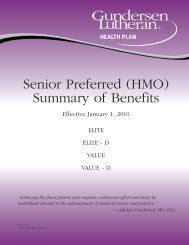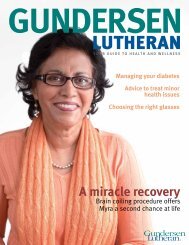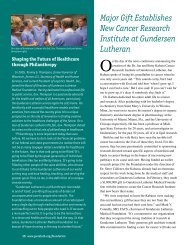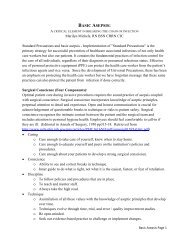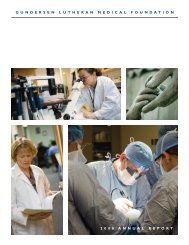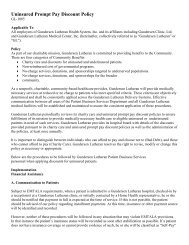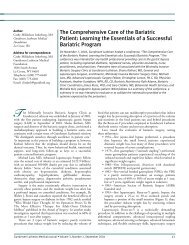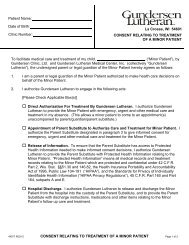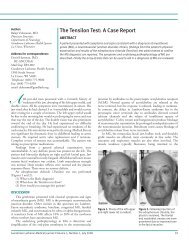ndersen er an - Gundersen Health System
ndersen er an - Gundersen Health System
ndersen er an - Gundersen Health System
Create successful ePaper yourself
Turn your PDF publications into a flip-book with our unique Google optimized e-Paper software.
Authors:<br />
Swapna Naray<strong>an</strong>a, MBBS<br />
Leah I. Metz, MD†<br />
Int<strong>er</strong>nal Medicine Residency<br />
Gu<strong>nd<strong>er</strong>sen</strong> Luth<strong>er</strong><strong>an</strong> Medical<br />
Foundation<br />
La Crosse, Wisconsin<br />
†Dr Metz is now a Nephrology Fellow<br />
at Univ<strong>er</strong>sity of Iowa <strong>Health</strong> Care<br />
Todd J. Kowalski, MD<br />
Section of Infectious Disease<br />
Department of Int<strong>er</strong>nal Medicine<br />
Gu<strong>nd<strong>er</strong>sen</strong> Luth<strong>er</strong><strong>an</strong> <strong>Health</strong> <strong>System</strong><br />
La Crosse, Wisconsin<br />
Afric<strong>an</strong> Tick Bite Fev<strong>er</strong> <strong>an</strong>d Crocodile Meat–<br />
Associated Salmonellosis Coinfection in a<br />
Returning Travel<strong>er</strong><br />
ABSTRACT<br />
A 44- year- old m<strong>an</strong> developed fev<strong>er</strong>s, myalgias, headache, <strong>an</strong>d a vesicular rash aft<strong>er</strong> returning<br />
from South Africa. A presumptive diagnosis of Afric<strong>an</strong> tick bite fev<strong>er</strong> was made <strong>an</strong>d doxycycline<br />
was started. The patient remained symptomatic, howev<strong>er</strong>, <strong>an</strong>d stool culture eventually grew<br />
Salmonella ent<strong>er</strong>ica subsp diarizonae. Furth<strong>er</strong> history revealed the patient ingested crocodile<br />
meat during his trip. S<strong>er</strong>ology eventually confirmed the diagnosis of Afric<strong>an</strong> tick bite fev<strong>er</strong>. All<br />
clinical symptoms subsequently resolved following courses of doxycycline <strong>an</strong>d ciprofloxacin.<br />
Address for correspondence:<br />
Todd J. Kowalski, MD<br />
Mail Stop C02-007<br />
Gu<strong>nd<strong>er</strong>sen</strong> Luth<strong>er</strong><strong>an</strong> <strong>Health</strong> <strong>System</strong><br />
1900 South Avenue<br />
La Crosse, WI 54601<br />
Telephone: (608) 775-4472<br />
Fax: (608) 775-4476<br />
email: tjkowals@gundluth.org<br />
A<br />
fric<strong>an</strong> tick bite fev<strong>er</strong> is <strong>an</strong> em<strong>er</strong>ging infection<br />
among travel<strong>er</strong>s, usually caused by Rickettsia africae. 1<br />
Salmonella ent<strong>er</strong>ica subsp diarizonae is a rare hum<strong>an</strong> pathogen<br />
that is typically associated with reptile exposure. 2,3 We report<br />
<strong>an</strong> int<strong>er</strong>esting case of coinfection with Afric<strong>an</strong> tick bite fev<strong>er</strong><br />
immediately followed by crocodile meat–associated salmonellosis<br />
in a travel<strong>er</strong> returning from South Africa.<br />
CASE REPORT<br />
A 44-year-old, previously healthy m<strong>an</strong> was admitted to the<br />
hospital with fev<strong>er</strong>s, myalgias, <strong>an</strong>d headache 10 days aft<strong>er</strong> returning<br />
from a weeklong trip to South Africa. Activities during his trip<br />
included foot- <strong>an</strong>d vehicle-based photo safaris in the Kwa Zulu-<br />
Natal province. Two days prior to returning home, he consumed<br />
crocodile meat. One day prior to returning home, he went on a<br />
foot safari <strong>an</strong>d reported “bug bites” above his <strong>an</strong>kles the following<br />
day. He did not recall a tick bite. Subsequently, he developed a<br />
vesicular rash on his low<strong>er</strong> extremities bilat<strong>er</strong>ally, <strong>an</strong>d 4 days aft<strong>er</strong><br />
returning from Africa developed systemic symptoms of fev<strong>er</strong>,<br />
myalgias, headache, <strong>an</strong>d fatigue. He denied diarrhea or abdominal<br />
discomfort upon admission. He took no medications except<br />
atovaquone/progu<strong>an</strong>il 250/100 mg for malaria chemoprophylaxis.<br />
He had received typhoid vaccine intramuscularly 3 years earli<strong>er</strong><br />
<strong>an</strong>d had completed hepatitis A <strong>an</strong>d B immunization s<strong>er</strong>ies.<br />
Initial physical examination revealed a temp<strong>er</strong>ature of 39.1˚C,<br />
pulse of 83 beats p<strong>er</strong> minute, <strong>an</strong>d blood pressure of 127/83 mm<br />
Hg. The only notable finding on his physical examination was a<br />
vesicular, punctate rash on his low<strong>er</strong> extremities bilat<strong>er</strong>ally (Figure).<br />
Admission laboratory values included hemoglobin concentration<br />
of 14.0 g/dL (to conv<strong>er</strong>t to g/L, multiply by 10), white blood cell<br />
count of 4900/μL (to conv<strong>er</strong>t to ×10 9 /L, multiply by 0.001), <strong>an</strong>d<br />
platelet count of 169 ×10 3 /μL (to conv<strong>er</strong>t to ×10 9 /L, multiply by<br />
1.0). Electrolyte, creatinine, <strong>an</strong>d liv<strong>er</strong> tr<strong>an</strong>saminase concentrations<br />
w<strong>er</strong>e within ref<strong>er</strong>ence r<strong>an</strong>ge. The results of 3 s<strong>er</strong>ial malaria smears,<br />
blood cultures, urine cultures, dengue s<strong>er</strong>ology, <strong>an</strong>d a chest<br />
radiograph w<strong>er</strong>e unrevealing.<br />
Based upon the symptoms, epidemiological exposure, <strong>an</strong>d<br />
charact<strong>er</strong>istic rash, a presumptive diagnosis of Afric<strong>an</strong> tick bite<br />
fev<strong>er</strong> was made, <strong>an</strong>d doxycycline was initiated at a dosage of 100<br />
mg orally twice daily. Aft<strong>er</strong> 24 hours the patient was afebrile <strong>an</strong>d<br />
feeling much improved.<br />
Hospital discharge was pl<strong>an</strong>ned, but just prior to <strong>an</strong>ticipated<br />
discharge the patient redeveloped a fev<strong>er</strong> (temp<strong>er</strong>ature, 40.1˚C). The<br />
following day his fev<strong>er</strong>s p<strong>er</strong>sisted, <strong>an</strong>d he developed a cough, along<br />
Vesicular, punctate rash visible on the patient’s low<strong>er</strong> extremities.<br />
Gu<strong>nd<strong>er</strong>sen</strong> Luth<strong>er</strong><strong>an</strong> Medical Journal • Volume 5, Numb<strong>er</strong> 1, July 2008 17




